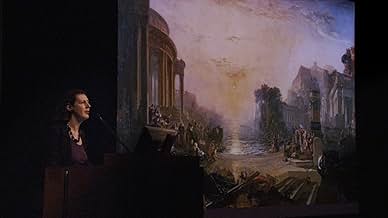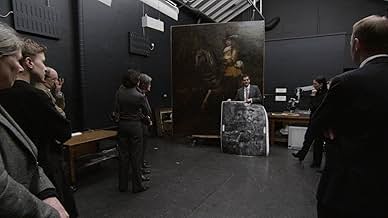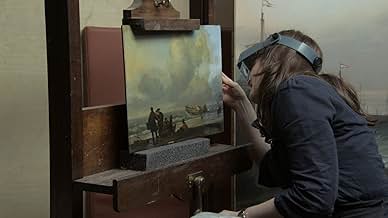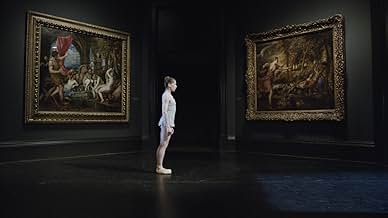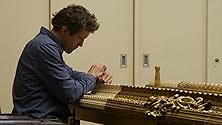IMDb-BEWERTUNG
7,3/10
1744
IHRE BEWERTUNG
Ein Dokumentarfilm, der das Innenleben eines der größten Museen der Welt erforscht: Die National Gallery in London.Ein Dokumentarfilm, der das Innenleben eines der größten Museen der Welt erforscht: Die National Gallery in London.Ein Dokumentarfilm, der das Innenleben eines der größten Museen der Welt erforscht: Die National Gallery in London.
- Regie
- Drehbuch
- Hauptbesetzung
- Auszeichnungen
- 1 Gewinn & 9 Nominierungen insgesamt
Larry Keith
- Self - director of conservation, National Gallery
- (Nicht genannt)
Nicholas Penny
- Self - director of the National Gallery
- (Nicht genannt)
Luke Syson
- Self - curator, National Gallery
- (Nicht genannt)
Empfohlene Bewertungen
Frederick Wiseman's new documentary NATIONAL GALLERY runs three hours; three hours of dissecting and analyzing the workings of one of the world's great Museums - the National Gallery in London England. Probing paintings' meaning and content; structure and design; the decisions involved in the way venerated and treasured works of art are conserved, restored, cleaned, lit and hung. We also are privy to the voices of the docents, curators, and staff talking about specific artworks connecting their audiences to the aesthetics, beauty, history, and science of conservation; the various pathways a painting takes from its original creation; its entry into various collections, and finally to its safe-keeping for posterity in the National Gallery Museum. We even listen to Nicholas Penny, the rumpled-haired Museum Director in a lecture taking a stab at Poussin - admitting that he is not sure if he likes the work, but is always intrigued by it.
Questions of elitism and exclusivity vs.accessibility and egalitarianism in light of budgetary considerations are discussed at meetings; there are lots of meetings. The film might have edited out some of the discussions - but I felt that the prosaic, the boring, the everyday-ness was worth observing. The running of a museum is not always glamorous. The decisions that establishments have to make in order to grip the public's interest - what lengths do they go to attract visitors, and at what price to their institution?
Wiseman just lets his camera roll; he never uses "voice overs". His working method and vitality at age 84 is unchanged - not intrusive - the filmmaker is always invisible - interviews are conducted by others. Frederick Wiseman lets us be the proverbial "fly on the wall" in a space that ordinarily would be bug-proof.
I loved watching one of the restorers discussing the cleaning of Velasquez' Christ in The House of Martha and Mary and passionately ponder the dilemma - do we over-strip the varnish used 100's of years ago and thereby brighten and change the artists' original intent? Ethical problems and compromises come into question. An in-house construction of a triptychs' impressive frame delicately carved by the crafts-men and women associated with the Museum, and the lighting of the finished piece held me spellbound, as did the issue of a cast shadow obscuring the top 1/4 of the painting once the work was installed. We also pay heed to restorers scraping away tiny slivers of paint with scalpels, Q-tips, eye-droppers, etc. and then put the minuscule paint shavings on a slide tray to be placed under a microscope to be scrutinized - to be thoroughly examined yielding a plethora of information; new scientific techniques today make this kind of investigation possible. We mark the fragility of time's passing on art realizing that there are effects that you have to live with, and guard against, but ultimately methodical and deductive technical intervention will be called upon to "save" the work from aging and deterioration.
The camera also takes us outside the Museum with aerial views of Trafalgar Square lit by the grays of daylight to the shimmering of the early darkness -focusing on the diverse community waiting patiently in the cold to to see the Da Vinci exhibition "Painter at the Court of Milan" (2012.) We are never far away from the human response to art - the intensity of the onlooker's gaze, the curiosity, confusion, delight, horror and interior peace that art can inculcate.
Other blockbusters such as "Turner Inspired by the light of Claude" and "Metamorphosis: Titian 2012" are exhibitions that we are fortunate to attend and hear curators/docents of varying sizes, ages and accents advocating for art's fascination and magnetism; confronting us with their disparate styles - some humorous, others psychoanalytical - all informative. Each artwork has a presence with an individual history and personal narrative imprinted on its essence - like life itself this movie is thrilling, enigmatic, complex and a singular jewel.
Questions of elitism and exclusivity vs.accessibility and egalitarianism in light of budgetary considerations are discussed at meetings; there are lots of meetings. The film might have edited out some of the discussions - but I felt that the prosaic, the boring, the everyday-ness was worth observing. The running of a museum is not always glamorous. The decisions that establishments have to make in order to grip the public's interest - what lengths do they go to attract visitors, and at what price to their institution?
Wiseman just lets his camera roll; he never uses "voice overs". His working method and vitality at age 84 is unchanged - not intrusive - the filmmaker is always invisible - interviews are conducted by others. Frederick Wiseman lets us be the proverbial "fly on the wall" in a space that ordinarily would be bug-proof.
I loved watching one of the restorers discussing the cleaning of Velasquez' Christ in The House of Martha and Mary and passionately ponder the dilemma - do we over-strip the varnish used 100's of years ago and thereby brighten and change the artists' original intent? Ethical problems and compromises come into question. An in-house construction of a triptychs' impressive frame delicately carved by the crafts-men and women associated with the Museum, and the lighting of the finished piece held me spellbound, as did the issue of a cast shadow obscuring the top 1/4 of the painting once the work was installed. We also pay heed to restorers scraping away tiny slivers of paint with scalpels, Q-tips, eye-droppers, etc. and then put the minuscule paint shavings on a slide tray to be placed under a microscope to be scrutinized - to be thoroughly examined yielding a plethora of information; new scientific techniques today make this kind of investigation possible. We mark the fragility of time's passing on art realizing that there are effects that you have to live with, and guard against, but ultimately methodical and deductive technical intervention will be called upon to "save" the work from aging and deterioration.
The camera also takes us outside the Museum with aerial views of Trafalgar Square lit by the grays of daylight to the shimmering of the early darkness -focusing on the diverse community waiting patiently in the cold to to see the Da Vinci exhibition "Painter at the Court of Milan" (2012.) We are never far away from the human response to art - the intensity of the onlooker's gaze, the curiosity, confusion, delight, horror and interior peace that art can inculcate.
Other blockbusters such as "Turner Inspired by the light of Claude" and "Metamorphosis: Titian 2012" are exhibitions that we are fortunate to attend and hear curators/docents of varying sizes, ages and accents advocating for art's fascination and magnetism; confronting us with their disparate styles - some humorous, others psychoanalytical - all informative. Each artwork has a presence with an individual history and personal narrative imprinted on its essence - like life itself this movie is thrilling, enigmatic, complex and a singular jewel.
If you are familiar with Wiseman's work, you know that he is a true documentarian. No Michael Moore-type bias, no opinions, just a pure document for you to do with what you will. I enjoyed every minute and learned much about the day-to-day life in London's National Gallery. I loved the staff lectures on different paintings, the restoration sections were fascinating, and even the board meetings were interesting (even though I hate meetings in real life LOL).
I'm only sorry Frederick Wiseman is getting older and cannot be with us for another 80 years so he can make even more documentaries. Brilliant, beautiful, sublime .
I'm only sorry Frederick Wiseman is getting older and cannot be with us for another 80 years so he can make even more documentaries. Brilliant, beautiful, sublime .
A wonderful documentary of the National Gallery, a great museum in London and one of the greatest in the world with a large collection of masterpieces dated back from 16th century. This documentary makes it a living museum through the exhibition of several paintings, the galleries and the public around them. There are several explanatary commentaries by the museum technicians about the paintings and some talks also about the museum direction and planning all with excellent quality and remarkable detail. Indeed one of the best movies of 2014.
As observational documentaries go, Frederick Wiseman's "National Gallery" is pretty close to sublime. In typical Wiseman style there's no voice-over and no score; he simply places his cameras and his microphones inside the buildings and lets us see the paintings and hear the words spoken by the staff, at meetings or in discussing the art with the public. It lasts for three hours and if you love great art you just might have an orgasm watching the flow of masterpieces lovingly framed and spoken about. However, if art isn't quite your bag this might be the most boring film ever made.
At least Wiseman doesn't do it all in one continuous take, the way Sokurov did with "Russian Ark" whose roving camera induced in me a feeling of seasickness. Wiseman plumps for detail and how. The art is, of course, extraordinary but so too are the faces of the punters who come to stare. The screen itself becomes a canvas in which Wiseman's camera paints the faces of these onlookers and it is beautiful to behold. What's less beautiful are the commentaries of the gallery's guides as they try to 'explain' the paintings to the various tour guides. Love it or loathe it, it isn't like any other film about 'art' that you are likely to see which is some sort of achievement in itself.
At least Wiseman doesn't do it all in one continuous take, the way Sokurov did with "Russian Ark" whose roving camera induced in me a feeling of seasickness. Wiseman plumps for detail and how. The art is, of course, extraordinary but so too are the faces of the punters who come to stare. The screen itself becomes a canvas in which Wiseman's camera paints the faces of these onlookers and it is beautiful to behold. What's less beautiful are the commentaries of the gallery's guides as they try to 'explain' the paintings to the various tour guides. Love it or loathe it, it isn't like any other film about 'art' that you are likely to see which is some sort of achievement in itself.
For those who enjoy the experience of visiting art museums, National Gallery' is a must-see. The brilliant objectivist documentarian Frederick Wiseman captures the iconic British museum from every side imaginable. Over the course of three hours, he offers a grand glimpse of the museum's collection and temporary exhibits as others look or discuss them, from art historians to tour guides. Fixed history and interpretation are celebrated in both Wiseman's camera and the loosely strung scenes of people in the exhibition halls. The movie cuts to various perspectives of the museum, from details of paintings to entire galleries, as people gaze at works. But Wiseman also captures the people operating the museums during PR and budget meetings and, most intriguingly, at work restoring paintings. No one looks at the camera to explain their work and Wiseman never even uses superimposed title cards, yet you will come away enlightened.
Wusstest du schon
- VerbindungenReferenced in Film Junk Podcast: Episode 493: Predestination (2014)
- SoundtracksSonate pour piano Op. 31 no 3
Music by Ludwig van Beethoven
Performed by Kausikan Rajeshkumar, RCM
dans la cadre de Belle Shenkamn Music Program (correct is "Belle Shenkman music programme")
[Récital]
Top-Auswahl
Melde dich zum Bewerten an und greife auf die Watchlist für personalisierte Empfehlungen zu.
- How long is National Gallery?Powered by Alexa
Details
- Erscheinungsdatum
- Herkunftsländer
- Offizieller Standort
- Sprache
- Auch bekannt als
- 歡迎光臨國家畫廊
- Drehorte
- Produktionsfirmen
- Weitere beteiligte Unternehmen bei IMDbPro anzeigen
Box Office
- Bruttoertrag in den USA und Kanada
- 253.941 $
- Eröffnungswochenende in den USA und in Kanada
- 10.049 $
- 9. Nov. 2014
- Weltweiter Bruttoertrag
- 354.971 $
- Laufzeit3 Stunden
- Farbe
- Seitenverhältnis
- 1.85 : 1
Zu dieser Seite beitragen
Bearbeitung vorschlagen oder fehlenden Inhalt hinzufügen

Oberste Lücke
By what name was National Gallery (2014) officially released in Canada in English?
Antwort






